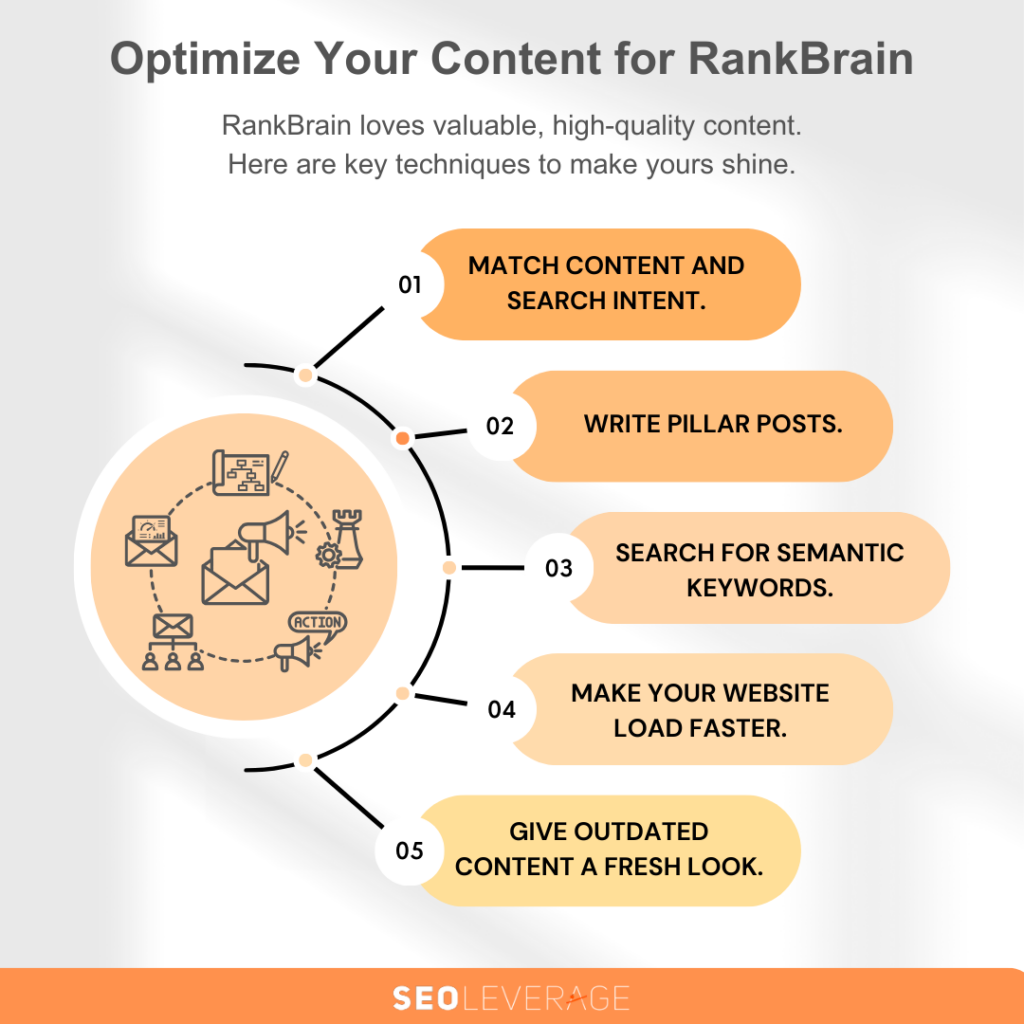Getting into SEO is some serious business. Aside from writing content, you have to keep up with the latest trends and practices in SEO to make your website rank first in search results. This also helps you to be on the good side of the search algorithm’s rules and regulations.
Introducing RankBrain, Google’s search algorithm. This is Google’s third most important signal that’s becoming increasingly important every day.
In this article, we’ll provide details on:
- What Google RankBrain is and how it works
- How RankBrain affects SEO
- How to optimize content for RankBrain
Table of Contents
Why is Rankbrain important?
RankBrain, an integral component of Google's search algorithm, plays a pivotal role in enhancing search results by interpreting complex queries and the intent behind them. This machine learning-based system is particularly adept at analyzing and understanding the nuances of human language, including colloquialisms and newly coined phrases, which traditional algorithms might struggle with. Its importance lies in its ability to continuously learn and adapt, ensuring that Google's search results remain relevant and accurate, even as language and search behaviors evolve. By effectively sorting and prioritizing search results based on user engagement and satisfaction, RankBrain significantly contributes to a more intuitive and efficient search experience, meeting the ever-changing needs of users worldwide.
How Does RankBrain Work?
First introduced by Google in 2015, RankBrain is a search algorithm that basically gives more relevant search results after processing large amounts of data. With machine learning, natural language understanding, and artificial intelligence in hand, RankBrain works its magic of predicting the best results out of a simple query.
RankBrain doesn’t work alone—it’s part of Hummingbird, Google’s overall search algorithm. It assists the Hummingbird in giving more accurate results when it can’t understand search queries after many tries.
RankBrain works with a simple logic. It processes and learns the pages people click on Google when they search for something to give valuable results. As time goes by, RankBrain continually understands the logic of searches. It matches the keywords people type on search engines with high-ranking and high-quality content.
How RankBrain Impacts SEO
These are some of the ways RankBrain can impact SEO in one way or another:
1. Understand user-experience metrics
Websites that have a lot of engagement and high user satisfaction tend to rank higher on search engines. RankBrain monitors these metrics on a website to make it recommendable to users:
- Click-Through Rate: Abbreviated as CTR, this metric refers to the percentage of people viewing a website and clicking a certain advertisement. Higher CTRs mean your website garners more interest and visitors and high ad revenue.
- Bounce Rate: This is the rate at which people leave a website because they’re not interested or engaged with the content. A high bounce rate is alarming for website owners.
- Time On Page: This is the time between a person viewing a page before clicking another. If there’s no moving to another page, no time on the page is calculated.
2. Search intent understanding
You might end up surprised when you get the information you need despite not using the exact keyword in a Google search. This is what RankBrain does: aligning the user’s intent with the most relevant search results even without using certain keywords. RankBrain understands what the user needs and delivers the needed content.
3. Help companies create better content
Websites with engaging content have greater chances of ranking high on a search engine. RankBrain prioritizes high-quality content, so it opens opportunities for you to improve your content for higher rankings.
4. Makes topics relevant
RankBrain works with a broader approach when it comes to topics. You don’t need to focus on a keyword but on how relevant a topic is. Doing so will give your website organic traffic from long-tail keywords.
5. Allows you to adapt to the algorithm
RankBrain has evolved and will still evolve over time. You need to work on your content and keep up with the algorithm to stay relevant. Adaptability is your greatest key to generating high traffic for your website.
Optimize Your Content for RankBrain
The best technique for optimizing content for RankBrain is anchored on creating valuable and high-quality information. Incorporate these key techniques into your content:

1. Match content and search intent.
There are four kinds of search intent:
- Commercial intent: This refers to the keywords that people put on the search bar before they buy something. Examples would be “best smartphones for 2023” or “best running shoes.”
- Navigational intent: This refers to people searching for a particular page. An example would be a login page of a certain website. The search query goes like this: “[name of website] login”
- Transactional intent: It’s a search intent that tells you that a customer is buying something. The search query example is: Buy [name of item].
- Informational intent: This means that a user wants more information on a certain topic. They typically type “What is [topic]” in the search box.
Write content that matches what the users want to know. If it’s a commercial intent, it’s best to write about product details, product descriptions, and reviews. Write blog posts and articles for keywords geared toward informational intent.
Pro tip when writing content: write in a conversational tone. Make it sound natural that it aligns with how users do their search queries.
2. Write pillar posts.
Pillar posts provide complete information on a broad topic. Writing one lets you explore different subtopics of the main topic.
These posts typically go from 1,000-2,000 words, depending on the topic’s nature and complexity. A pillar article can be a guide, a how-to, or a what-is page—one that discusses a certain topic extensively.
Pillar posts offer these benefits for your website:
- Get high organic traffic. Pillar posts contain short-tail keywords or terms that people search more often than others. Incorporating these keywords in your content may give you more chances of your site getting viewed upon search.
- Gives more backlinks. Writing pillar posts increases the chances of getting backlinks from more authoritative sources. Bloggers tend to choose well-written articles with complete information.
- Get a structure that’s easy to understand. Pillar posts are outlined from start to finish. With this outline, it’s easier for you to understand the flow of the whole article. You can even jump to the part you want and get the info you need.
3. Search for semantic keywords.
Semantic keywords are words related to the main keyword. These words help search engines understand your content and rank your website more accurately.
Adding the semantic keywords that you find helps you be on the same level as your competitors. Your website might get noticed as it contains relevant content that others may find useful.
Although there’s no limit to using semantic keywords, choose those that you think can bring value to your content. It’s always quality versus quantity. Avoid stuffing too many keywords in an article.
4. Make your website load faster.
Websites with slow loading times contribute to bounce rates. If it loads slowly, people tend to leave your site just a few seconds later. In contrast, fast-loading websites can give users the information they need. People stay on the site longer and explore it.
One way to load your website faster is to resize and remove photos and videos. When your site has fewer of these, it becomes easier for it to speed up. Change the file formats of your files to reduce the weight it gives to your website.
5. Give outdated content a fresh look
Algorithms and trends change over time. Some of the content you wrote years ago doesn’t make sense now.
Instead of writing new articles, which can deplete your ideas, going back to your previous posts will give you a new perspective. A blast from the past, as they say.
Choose an old article to rewrite. Do some keyword research and fact-checking to give it a fresh take. This might just give your site a boost for RankBrain to rank your newly rewritten articles.
Another pro tip: Do not rewrite articles that contain specific years.
Work With Us!
Imagine your website is getting low traffic due to various factors. It might be due to poor content or horrible website design. And when your website doesn’t get many visitors, your business gets affected in the process.
Here at SEOLeverage, we’re ready to turn that around! We’re committed to working on your website to make it a high-traffic one. Here’s why you should choose us:
- Expert and experienced team. SEOLeverage is made up of people who work hard and collaborate to bring the best out of your website. From SEO technicals to writing and promotions, this team boasts expertise that can help propel your business to greater heights.
- Solutions that cater to your needs. We make sure that every solution we present to you is catered to your SEO needs. Believe us when we say that we’ve studied your website from the inside out. We have the solutions you need to get your site back on track.
- We’re in for the results. We work with a results-driven approach in mind. We make sure that every step we take is good for your website.
Whether you want to optimize for RankBrain to be one of the relevant search results on Google algorithm or you just want to get your website seen, we have the best team, tools, and strategies to make them happen.
The SEO and the search engine land, in general, are moving too fast. With RankBrain matching results with the user’s queries, your content has to be optimized well to get a high site ranking. Send us a message, so we can help you unleash your website’s potential to the fullest in line with the Google RankBrain algorithm!

